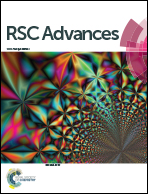A sensitive electrochemical immunosensor for the detection of human chorionic gonadotropin based on a hierarchical nanoporous AuAg alloy†
Abstract
A sensitive electrochemical immunosensor for the detection of human chorionic gonadotropin (hCG) is designed based on a novel signal amplification strategy. A hierarchical nanoporous (HNP) AuAg alloy with the advantages of a large surface area, excellent structure stability, and rich pore channels is used as an hCG antibody carrier for the preparation of a highly sensitive immunosensor. The HNP-AuAg alloy with bimodal ligament/pore size distribution is fabricated by means of simple dealloying and redealloying of the AuAgAl source alloy combined with an annealing operation. Graphene sheets (GS) and ionic liquid (IL) composites have been introduced as transducing materials to modify the conductivity as well promote the electron transfer in the immunosensor. Based on the dual-amplification effects of the HNP-AuAg alloy and the IL/GS composite film, the constructed immunosensor exhibits an enhanced performance for hCG detection compared with that based on single nanoporous (NP) Au, including a lower detection limit of 0.01 ng mL−1 and wider linear range from 0.05 to 35.0 ng mL−1. Moreover, the immunosensor exhibits respectable reproducibility and stability, indicating a potential application in clinical monitoring of hCG.


 Please wait while we load your content...
Please wait while we load your content...